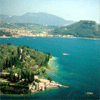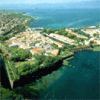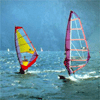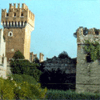|
|
|
Lake Garda - Eastern side Guide Italy
|
 |
 |
 |
 |
|
|
|
|
Directories of Web Sites:
Lake Garda - Eastern side Italy
Lake Garda - Eastern side Hotels
Lake Garda - Eastern side Guide
Lake Garda is blessed with more than 45 km of free beaches in some of the most evocative and celebrated scenery of whole Europe, including medieval towns, historical villas and ancient castles. It is enriched by its green hinterland with pastures and vineyards which produce wines known throughout the world such as Custoza and Bardolino. Motor-boating, water-skiing, wind-surfing and fishing are the most popular sports on the lake, while, for some years now, the hills have become much appreciated by those who love to enjoy their sport surrounded by greenery, and offer golf, horseback riding, mountain walking, and this is thanks to shrewd valuation in an "ecological"sense. Furthermore, this area boasts the biggest Italian Funfair: Gardaland
Its name is linked in the XIIIth Century the the town of Garda (from "wanda" - watchpoint), on the East Coast near Bardolino, gives its name to the whole Lake which had been called until that moment " Benaco". From Sirmione with its Castle and grottoes immortalized by the Latin poet Catullus, to Lazise, surrounded by its medeval walls, the Veronese slope on the lower lake is a contination of hills. The towns of Garda, Punta San Vigilio and Torri are the most beautiful spots of the middle lake. It is here that the scenery of the hinterland begins to change and the hills begin to make way for the rocky mountainous sides of the Pre-Alps. These tourist centres are aslo medieval towns and therefore have castles, villas and monasteries.
The hermitage of the Camaldolesi friars lies on one of the highlands, the other is the Rock of Garda, which separate the towns of Bardolino and Garda. The Convent was built in 1663. The project was to build two-roomed small buildings containing the friars' cells around a central vegetable garden. There is also a guest quarters and a library. From the Belvedere overlooking the lake there is a path with cypresses on either side, which surround the whole hermitage offering emotional glimpses of the Lake. The two hermits Benigno and Caro lived between the 8th and the 9th Century, they chose to retreat to the mountain above Malcesine. In the area they were very well known and venerated for their sanctity. Pipino, Carlo Magno's son turned to them for help in transporting the mortal remains of St. Zeno, for whom a new church had been built in Verona.
There is a three hours' walk on foot to reach the Hermitage (at normal walking speed), and as the hermitage is about 800 metres above sea level, one needs a bit of training to climb up.
The famous gastronomic products of the area are: Wine, Oliveoil, Asparagus, Fish, Chestnut, Cheese, Honey, Tortellini, Truffle and Pumpkins. The story of oil-milling from its beginning as a rural activity to the dawning of the technological age, is the theme of the Oil Museum realized by the oil-mill in Cisano del Garda. The museum shows how oil has been produced in rural society for centuries. It also tells us the story of a community without scientific knowledge and means applying itself to the extraction of a fundamentally important foodstuff from a precious fruit : the olive. The journey through history is marked by any changes in technology which remains constant throughout the ages utill the beginning of the twentieth century, when the growing industry offered opportunities of mechanisation.
The Wine Museum was created by the Zeni Brothers from Bardolino who founded this historic cellar in 1870 for the exhibition of tools: ploughs, heads, presses, manual decanting pumps, copper tables with the tools required for the production of wine-drums and all the equipment for working in the cellar and the grapevines. There are photographs explaining and giving information on the D.O.C. wine produced in the area. The museum leads to the cellar where wine can be bought.
The Wines produced on the Riviera Veronese of Lake Garda are successfully exported all over the world. The typical ones, granted by brand names of controlled origin, are: the Bardolino, in its versions Classico, Chiaretto and Novello, the Bianco di Custoza, the Valdadige and the Lugana. Those who intend to stay in the region have the possibility to discover the places where wine is produced, visit the great number of cellars situated along the "wine routes" and buy wine directly from the vineyard owners. Wine lovers must absolutely consider a visit to the wine museum in Bardolino to admire the exhibition of the historical tools used in the wine production as well as a photo-gallery of all the DOC wines produced in the area of Verona.
The Museum Scaligero, located at Torri del Benaco, is very important for ethnological aspects and it shows some objects connected to the trades carried out in the area: one room shows the activities of the "calafati", artisans dedicated to repairing fishing boats of inland waters; in the room of the inhabitants there is the story of the fishermen guilds of the ancient inhabitants of Torri and Garda started in 1452 and still working today. One section illustrates the rock graffiti of Lake Garda which has prehistoric origins. Inside the castle a small botanical kitchen garden collects the main plants of the environment of the place (sub-Mediterranean vegetation) and, leaning on the southern part of the castle we find one of the few greenhouses for citrus fruit still working around Garda, it dates back to 1760.
Other important museums are: the Museo Scaligero at Malcesine; the Civic Museum at Caprino Veronese; Museo Palazzina storica at Peschiera del Garda; the Napoleonic Museum at Rivoli Veronese; the Archeological Museum at Cavaion Veronese.
(Part of the Contents and the Images are gently given by APT 12 Garda) |
|
|
|
Acquista la tua visibilità su Travel Plan
|
|
|
|